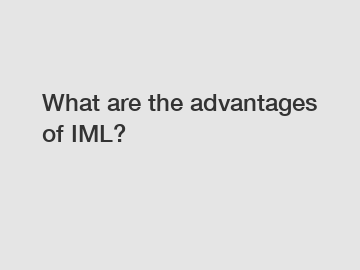What are the advantages of IML?
Advantages of In-Mold Labeling (IML).
In-Mold Labeling (IML) is a popular technique used in the packaging industry to enhance the appearance and functionality of products. It involves the integration of labels during the manufacturing process by placing them inside the mold before injecting the material. This innovative method provides several advantages over traditional labeling techniques. In this article, we will explore the benefits of IML.
Improved Design Flexibility.

One of the key advantages of IML is its ability to offer enhanced design flexibility. With conventional labels, designers often face limitations in terms of shape, size, and color. However, IML allows for greater artistic freedom as labels can be seamlessly integrated with the product surface. Whether it is a complex shape, detailed graphics, or vibrant colors, IML enables limitless design possibilities. This flexibility fosters product differentiation and helps brands stand out in a competitive market.
Enhanced Durability and Resistance.
IML labels are incredibly durable and resistant to various environmental factors. Unlike traditional labels that can easily peel off or fade over time, IML labels are fused with the product during the molding process. This fusion eliminates the risk of labels coming off or getting damaged during transportation, storage, or everyday use. IML labels can withstand exposure to moisture, chemicals, UV rays, temperature changes, and even high levels of friction. This longevity ensures that the product's branding and information remain intact throughout its lifecycle.
Cost-Effective Solution.
While the initial investment in IML may be slightly higher compared to traditional labeling techniques, the long-term cost benefits make it a viable solution. IML eliminates the need for additional labeling processes, adhesive application, and subsequent quality control measures required with other labeling methods. The integration of labels during the manufacturing stage streamlines the overall production process, reducing labor costs and saving time. Moreover, since IML labels are highly resistant to damage, manufacturers can avoid extra expenses associated with label replacements and repairs.
Efficient Product Identification.
IML labels play a crucial role in product identification. They can incorporate various types of information, such as brand logos, product names, barcodes, nutrition facts, safety instructions, and regulatory compliance symbols. With IML, all this information can be included directly on the product surface, ensuring clear and accurate labeling. This not only facilitates easy identification for consumers but also simplifies inventory management, traceability, and compliance with labeling regulations.
Enhanced Shelf Appeal.
The aesthetics of a product play a significant role in consumer buying decisions. IML labels enhance the shelf appeal of products, making them more attractive to potential buyers. The seamless integration of labels with the product surface provides a visually appealing and premium look. The ability to incorporate high-quality graphics, vibrant colors, and textured effects further enhances the product's overall appearance. As a result, products with IML labels stand out amongst competitors, increasing the chances of purchase.
Conclusion.
In-Mold Labeling (IML) offers numerous advantages that make it a preferred choice for packaging manufacturers. Its design flexibility, durability, cost-effectiveness, efficient product identification, and enhanced shelf appeal make IML a valuable solution for brands looking to create a lasting impact in the market. By investing in IML, companies can differentiate their products, ensure accurate labeling, and attract more consumers.
For more information about In-Mold Labeling and its benefits, please contact us.
If you want to learn more, please visit our website Margarine container manufacturers, Plastic Biscuit buckets, 125ml IML Ice Cream Container.
200
0
0

Comments
All Comments (0)